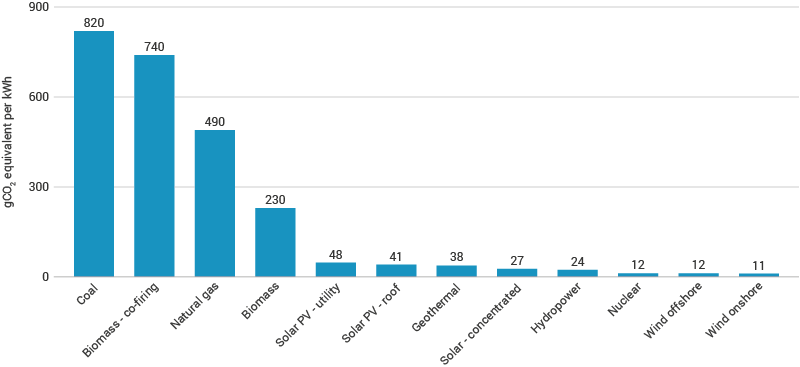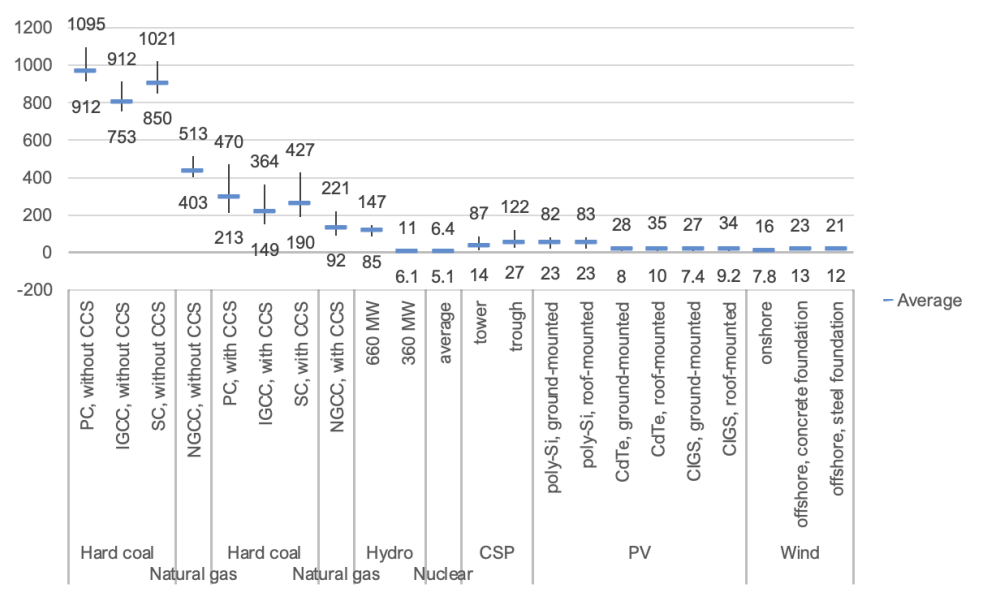Carbon Dioxide Emissions From Electricity
(Updated October 2022)
- Over 40% of energy-related carbon dioxide (CO2) emissions are due to the burning of fossil fuels for electricity generation.
- All electricity generation technologies emit greenhouse gases at some point in their life-cycle.
- Nuclear fission does not produce any CO2. For both nuclear and renewable generation, emissions are produced indirectly, for example during the construction of the plant.
- Over its life-cycle, nuclear produces about the same amount of CO2-equivalent emissions per unit of electricity as wind, and about one-third that of solar.
Energy-related greenhouse gas emissions account for the majority of all anthropogenic emissions – about 80% in the USA and the European Union, for example. Just 20% of final energy consumption is in the form of electricity, but the generation of electricity is responsible for over 40% of all energy-related emissions.
Worldwide emissions of carbon dioxide (CO2) from burning fossil fuels total about 34 billion tonnes (Gt) per year. About 45% of this is from coal, about 35% from oil and about 20% from gas.
The impacts of electricity generation go beyond the emission of CO2 and other greenhouse gases. For more information see pages on:
Global warming and greenhouse gas emissions
The greenhouse effect refers to how certain gases in the Earth’s atmosphere allow short-wave radiation in, but trap long-wave thermal radiation emitted from the Earth’s surface. This is what keeps the Earth habitable – it would otherwise be too cold at night. However, a build-up of greenhouse gases, notably CO2, is causing warming of the climate in many parts of the world.
While our understanding of relevant processes is advancing, we do not know how much CO2 the environment can absorb, nor exactly how the long-term global CO2 balance is maintained. The consensus of scientific opinion is increasingly concerned about the steady worldwide build-up of CO2 levels in the atmosphere, and some major political initiatives reflect this. The CO2 build-up is occurring as the world’s carbon-based fossil fuels are being burned and rapidly converted to atmospheric CO2, e.g. in motor vehicles, domestic and industrial furnaces, and electric power generation. Progressive clearing of the world’s forests also contributes to the greenhouse effect by reducing the removal of atmospheric CO2 by photosynthesis. These facts are aligned with evidence that the Earth is warming.
As early as 1977, a US National Academy of Sciences report concluded: “The primary limiting factor on energy production from fossil fuels over the next few centuries may turn out to be the climatic effects of the release of carbon dioxide,” though the precise effects were uncertain.1 Today the apparent climate effect of CO2 has become a widespread concern, and has a major influence on decisions about how electricity should be generated.
Life-cycle emissions of electricity options
On a life-cycle basis, nuclear power emits just a few grams of CO2 equivalent per kWh of electricity produced. Whilst estimates vary, the United Nations (UN) Intergovernmental Panel on Climate Change (IPCC) has provided a median value among peer-reviewed studies of 12g CO2 equivalent/kWh for nuclear, similar to wind, and lower than all types of solar.2

Figure 1: Average life-cycle CO2 equivalent emissions (source: IPCC)

Figure 2: Average life-cycle emissions (grams of CO2 equivalent per kWh) (source: UNECE)
In March 2022 the UN's Economic Commission for Europe (UNECE) estimated a range of 5.1-6.4 g CO2 equivalent per kWh for nuclear3, the lowest among all low-carbon technologies.
To reduce emissions sufficiently, all energy sectors will need to be decarbonized. However, much of the immediate focus is on the electricity sector for several reasons:
- The electricity sector is the most readily-decarbonized, as it provides the means to use non-fossil low-carbon energy (e.g. hydro, nuclear, wind and solar).
- Electricity is clean at the point of final use. This has two main advantages: improving air quality in urban areas; and centralizing energy-related emissions (i.e. at power stations), making emissions regulation more straightforward.
- Generating electricity is emissions-intensive. About 20% of final energy consumption is in the form of electricity, but the generation of electricity is responsible for over 40% of all energy-related emissions.
Despite the focus on electricity, limited progress has been made to date. 50% more electricity is generated today from fossil fuels than 20 years ago.
Capturing emissions
There are proposals for capturing the CO2 emissions from burning fossil fuels in large plants such as power stations and then injecting them deep underground – so-called carbon capture and storage (CCS). Though geological disposal of CO2 has been demonstrated, the effective capture of CO2 from power stations is difficult and expensive. Despite the application of significant R&D funding for CCS, there has been little progress in demonstrating its technical feasibility. The UN Intergovernmental Panel on Climate Change (IPCC) estimated that it would increase the fuel needs of a power station by at least 25%, and likely double the price of electricity.4
The UNECE has estimated that life-cycle greenhouse gas emissions for coal and natural gas utilizing CCS remain high (see Figure 2).
Notes & references
General sources
International Energy Agency, Data and Statistics
International Energy Agency, World Energy Outlook 2020
References
1. National Research Council, Energy and Climate: Studies in Geophysics, The National Academies Press (1977) [Back]
2. Steffen Schlömer (ed.), Technology-specific Cost and Performance Parameters, Annex III of Climate Change 2014: Mitigation of Climate Change. Contribution of Working Group III to the Fifth Assessment Report of the Intergovernmental Panel on Climate Change (2014) [Back]
3. Carbon Neutrality in the UNECE Region: Integrated Life-cycle Assessment of Electricity Sources, United Nations Economic Commission for Europe (March 2022) [Back]
4. Chapter 8: Cost and economic potential, from IPCC Special Report on Carbon Dioxide Capture and Storage, prepared by Working Group III of the Intergovernmental Panel on Climate Change (2005) [Back]